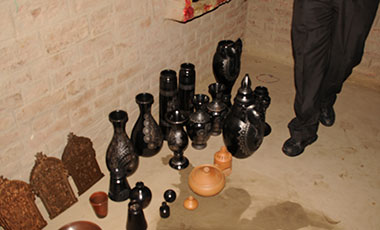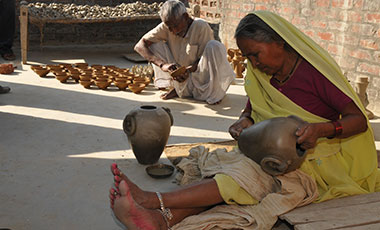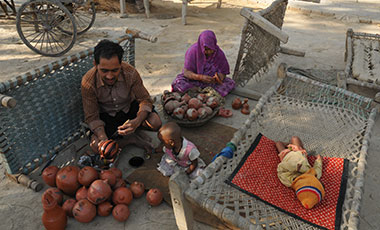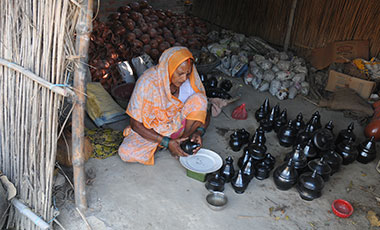Indian Trust for Rural Heritage and Development (ITRHD)
Just as the universe is contained in the self, so is India contained in the villages
- Mahatma Gandhi
Just as the universe is contained in the self, so is India contained in the villages
- Mahatma Gandhi
The village of Nizamabad is famous for a unique form of black pottery, often embellished with inlaid silver patterns. The art originated in the Kutch region of Gujarat; the inheritors of the tradition migrated to Azamgarh during the reign of the Mughal Emperor Aurangzeb. In 2015, this distinctive tradition was acknowledged by earning Geographical Indications status.
The village is densely populated, and suffers from lack of civic infrastructure. Poverty is widespread in the community, even though cost of production is minimal, as the clay is procured from village ponds, and mixed with goat excreta. The wheels on which the objects are formed are operated with electricity, as and when available. Otherwise, they are operated manually.


Designs are etched or painted on objects when they come from the wheel, then baked in clay ovens. The ovens are covered, which results in the distinctive glossy black colour. The silver designs are imparted with mercury. The unique beauty of the products has won their creators Master Craftsman awards, and resulted in one potter being sent to a Government sponsored exhibition in Europe. Nevertheless, the potters were for the most part at the mercy of traders from Mumbai, who bought the major part of their production and paid the potters no more than a pittance.
When ITRHD began working with Nizamabad, we realized that there were several major problems. In terms of production, the clay ovens used by them did not have any temperature control. For lack of uniformity of temperature, very often the objects were of poor quality, resulting in cracking and also leakage of liquids. This made the products unsuitable for food and even for use as flower containers. In addition, the use of mercury makes the objects unsafe for use in cooking or food presentation. The lack of direct access to markets also kept the artisans totally dependent on, and exploited by, traders.
ITRHDs initiatives in Nizamabad are thus covering several areas. We have involved experts in relevant fields to work on developing a kiln that can be used for oxidation and reduction techniques, with additional fuel efficiency. This will help the potters gauge the temperature that the kiln has reached, thus taking care of the potters problem of temperature control for maintaining quality. Some of the artisans were sent to Rajasthan to work with Leela Bordia at the famous Neerja Blue Pottery workshop, where Mrs. Bordia was kind enough to help them with exposure to alternate design and technical skills. As a pilot project, a solar panel was installed in the village, funded and supervised by an international member of our Advisory Board.


To reduce the artisans dependence on middlemen and increase their access to markets, support is being provided through Azamgarh Festivals organised on an annual basis in Delhi and Lucknow where they are able to sell directly to local customers. See Azamgarh And Patiala Cultural Festivals. In addition, we have helped them gain admittance to the annual Surajkund Crafts Mela and India International Trade Fair.
As a result of these initiatives, the economic conditions are improving, and a few artisans who had left the village have returned. In addition, a new sense of pride and dignity in their tradition will, we hope, ensure its survival and the well-being of its talented practitioners.
